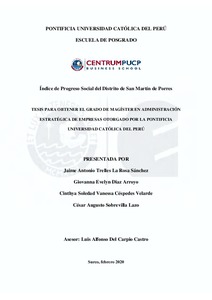| dc.contributor.advisor | Del Carpio Castro, Luis Alfonso | |
| dc.contributor.author | Trelles La Rosa Sánchez, Jaime Antonio | |
| dc.contributor.author | Diaz Arroyo, Giovanna Evelyn | |
| dc.contributor.author | Céspedes Velarde, Cinthya Soledad Vanessa | |
| dc.contributor.author | Sobrevilla Lazo, César Augusto | |
| dc.date.accessioned | 2020-07-09T22:07:21Z | |
| dc.date.available | 2020-07-09T22:07:21Z | |
| dc.date.created | 2020 | |
| dc.date.issued | 2020-07-09 | |
| dc.identifier.uri | http://hdl.handle.net/20.500.12404/16660 | |
| dc.description.abstract | El presente estudio tiene como objetivo calcular el Índice de Progreso Social [IPS] del
distrito de San Martín de Porres, según la metodología definida por el Social Progress
Imperative [SPI]. A fin de cumplir con dicho objetivo, se recopiló información de fuentes
primarias y secundarias. Como fuente primaria se llevó a cabo una encuesta en el distrito.
Como fuentes secundarias, se tomaron en consideración publicaciones de distintas entidades
públicas y privadas, así como información recabada en reuniones sostenidas con los
funcionarios de la Municipalidad Distrital de San Martín de Porres [MDSMP].
El distrito de San Martín de Porres obtuvo, como resultado del estudio, un IPS de
60.68, en una escala de 0 a 100, lo que refleja un nivel de progreso social medio bajo, según
la escala definida por el SPI. Con relación a las tres dimensiones que componen el IPS, el
resultado más alto se observa en la dimensión de Necesidades Humanas Básicas con 80.89
puntos, y un nivel de progreso social alto. Las dimensiones de Fundamentos del Bienestar, y
Oportunidades, reflejan un nivel de progreso social bajo, con puntajes de 50.98 y 50.78,
respectivamente. En lo que respecta a las zonas del distrito, la Zona II obtiene el resultado
más alto, 68.21 puntos, lo que corresponde a un nivel de progreso social medio alto. Las
zonas I, IV y V, obtuvieron puntajes de 61.80, 61.24 y 56.23 respectivamente, lo que las
ubica en un nivel de progreso social medio bajo.
A partir del análisis de dichos resultados, se identificaron oportunidades de mejora y
se plantearon diferentes recomendaciones para elevar el progreso social y solucionar los
principales problemas que afectan al distrito de San Martín de Porres, las cuales han sido
plasmadas en las matrices que se encuentran contenidas en el Capítulo V de este trabajo. La
primera matriz asocia las recomendaciones planteadas con los problemas identificados y la
segunda matriz asocia tales recomendaciones con los indicadores del modelo IPS y los
objetivos estratégicos de la MDSMP. | es_ES |
| dc.description.abstract | The objective of this study was to calculate the Social Progress Index [SPI] of San
Martín de Porres district, based on Social Progress Imperative [SPI] methodology. In order to
meet the aforementioned objective, primary and secondary sources of information were used.
As a primary source, a survey was conducted in the district. As secondary sources,
documents from different public and private entities were used, as well as the information
obtained in the meetings held with the district officials.
The district of San Martín de Porres obtained an SPI of 60.68, on a 0 to 100 scale,
which reflects a low social progress level according to the scale defined by the SPI.
Regarding the three dimensions in which the SPI is disaggregated, the highest score is
observed in the Basic Human Needs dimension with 80.89 points, and a high level of social
progress. The Foundations of Wellbeing and Opportunity, dimensions showed a low level of
social progress, with scores of 50.98 and 50.78 points respectively. Regarding the district
zones, Zone II obtained the highest score, 68.21 points, with a medium high level of social
progress. Zones I, IV and V, obtained scores of 61.80, 61.24 and 56.23 respectively, showing
a medium low level of social progress.
After analyzing these results, improvement opportunities were identified, based on
which several recommendations were made to improve social progress and solve identified
problems affecting San Martín de Porres district. These recommendations are presented in
two matrixes in chapter V. The first matrix shows the relationship between the
recommendations and the identified problems. The second matrix shows the relationship
between the recommendations, the SPI model indicators, and the strategic objectives defined
by the Municipality of San Martín de Porres. | es_ES |
| dc.language.iso | spa | es_ES |
| dc.publisher | Pontificia Universidad Católica del Perú | es_ES |
| dc.rights | info:eu-repo/semantics/openAccess | es_ES |
| dc.rights.uri | http://creativecommons.org/licenses/by-nc-nd/2.5/pe/ | * |
| dc.subject | Indicadores económicos--Perú--San Martín de Porres (Lima : Distrito) | es_ES |
| dc.subject | Indicadores sociales--Perú--San Martín de Porres (Lima : Distrito) | es_ES |
| dc.subject | Investigación cuantitativa | es_ES |
| dc.title | Índice de progreso social del distrito de San Martín de Porres | es_ES |
| dc.type | info:eu-repo/semantics/masterThesis | es_ES |
| thesis.degree.name | Maestro en Administración Estratégica de Empresas | es_ES |
| thesis.degree.level | Maestría | es_ES |
| thesis.degree.grantor | Pontificia Universidad Católica del Perú. CENTRUM | es_ES |
| thesis.degree.discipline | Administración Estratégica de Empresas | es_ES |
| renati.advisor.dni | 07535773 | |
| renati.advisor.orcid | https://orcid.org/0000-0001-9084-1193 | es_ES |
| renati.author.dni | 10137254 | |
| renati.author.dni | 40647612 | |
| renati.author.dni | 41822547 | |
| renati.author.dni | 41822543 | |
| renati.discipline | 413307 | es_ES |
| renati.level | https://purl.org/pe-repo/renati/level#maestro | es_ES |
| renati.type | https://purl.org/pe-repo/renati/type#tesis | es_ES |
| dc.publisher.country | PE | es_ES |
| dc.subject.ocde | https://purl.org/pe-repo/ocde/ford#5.02.04 | es_ES |






